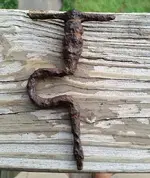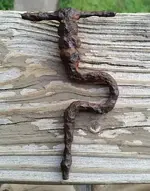ATpro5
Hero Member
- Joined
- Jan 4, 2013
- Messages
- 583
- Reaction score
- 191
- Golden Thread
- 0
- Location
- SW Virginia
- Detector(s) used
- Whites Coinmaster,At Pro,Minelab Etrac
- Primary Interest:
- All Treasure Hunting
Hello everyone, I found this iron thing-ama-jig at a site that is supposedly connected to confederate cavalry. Seeing how I found a ton of blacksmith made horseshoes, and I mean a ton, i'm guessing that assumption is spot on. Although I do not know what this thing really is, it has sparked my interest so I was hoping someone with some experience could tell me. For some reason, when I look at it I automatically think of a drill... The end of it looks like it was inserted into the tool... kind of like a drill bit, But I don't know. Did they even have drills in the civil war Hopefully someone tells me its a Rare drill used on cannons which only 2 are known to exist, andddd is worth around $5,000. Haha! Thanks in advance. Oh and also, I cleaned it with an steel brush and finished it off with some oil.
Hopefully someone tells me its a Rare drill used on cannons which only 2 are known to exist, andddd is worth around $5,000. Haha! Thanks in advance. Oh and also, I cleaned it with an steel brush and finished it off with some oil.


 Hopefully someone tells me its a Rare drill used on cannons which only 2 are known to exist, andddd is worth around $5,000. Haha! Thanks in advance. Oh and also, I cleaned it with an steel brush and finished it off with some oil.
Hopefully someone tells me its a Rare drill used on cannons which only 2 are known to exist, andddd is worth around $5,000. Haha! Thanks in advance. Oh and also, I cleaned it with an steel brush and finished it off with some oil.

Amazon Forum Fav 👍
Upvote
4




